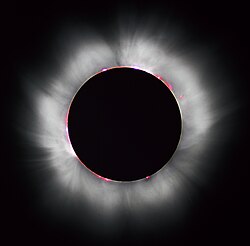A
- A-type star
- In the Harvard spectral classification system, a class of main-sequence star having spectra dominated by Balmer absorption lines of hydrogen. Main-sequence stars of spectral class A are typically blue-white or white in color, measure between 1.4 and 2.1 times the mass of the Sun, and have surface temperatures of 7,600–10,000 kelvin. [1]
- absolute magnitude
- A measure of a star's absolute brightness. It is defined as the apparent magnitude the star would show if it were located at a distance of 10 parsecs, or 32.6 light-years. [2] [3]
- accretion disk
- A roughly circular mass of diffuse material in orbit around a central object, such as a star or black hole. The material is acquired from a source external to the central object, and friction causes it to spiral inward towards the object. [4]
- active galactic nucleus (AGN)
- A compact region in the center of a galaxy displaying a much higher than normal luminosity over some part of the electromagnetic spectrum with characteristics indicating that the luminosity is not produced by stars. A galaxy hosting an AGN is called an active galaxy. [5]
- airborne observatory
- An airplane with an astronomical telescope, which relies upon altitude to reduce atmospheric absorption and improve seeing conditions. Drawbacks include the instability of the lifting platform and higher costs.
- albedo
- A measure of the proportion of the total solar radiation received by an astronomical body, such as a planet, that is diffusely reflected away from the body. It is a dimensionless quantity typically measured on a scale from 0 (indicating total absorption of all incident radiation, as by a black body) to 1 (indicating total reflection). The albedo reported for an astronomical body may vary widely by the spectral and angular distribution of the incident radiation, by the "layer" of the body being measured (e.g. upper atmosphere versus surface), and by local variation within these layers (e.g. cloud cover and geological or environmental surface features).
- albedo feature
- A large area on the surface of a reflecting object that shows a significant contrast in brightness or darkness (albedo) compared to adjacent areas.
- Alfvén surface
- The boundary separating a star's corona from the stellar wind, defined as the point at which the coronal plasma's Alfvén speed equals the large-scale stellar wind speed.
- Am star
- A chemically peculiar star belonging to the more general class of A-type stars. The spectrum of the Am stars shows abnormal enhancements and deficiencies of certain metals. They are generally slow rotators, and are often found in binary systems where tidal braking has slowed the rate of spin. [6] See metallicity .
- aphelion
- The point at which a body orbiting the Earth's Sun is furthest from the Sun. [7] Contrast perihelion .
- apoapsis
- The point at which an orbiting body is furthest from its primary. [7] Contrast periapsis .
- apogee
- The point at which a body orbiting the Earth (such as the Moon or an artificial satellite) is furthest from the Earth. [7] Contrast perigee .
- apparent magnitude
- A measure of the brightness of a celestial body as seen by an observer on Earth, adjusted to the value it would have in the absence of the atmosphere. The brighter the object appears, the lower its magnitude.
- appulse
- The closest approach of one celestial object to another, as viewed from a third body. [3]
- apsis
- In the orbit of a planetary body, one of the two extreme points of distance between the body and its primary – either the point of minimal distance, called the periapsis, or the point of maximal distance, called the apoapsis. The term may also be used to refer to the value of the distance rather than the point itself. All elliptical orbits have exactly two apsides.
- argument of periapsis
- The angle from an orbiting body's ascending node to its periapsis, measured in the direction of motion. It is one of six canonical orbital elements used to characterize an orbit.
- artificial satellite
- An object that has been intentionally placed into orbit by humans, often around the Earth but also around other bodies within the Solar System. [8] Contrast natural satellite .
- ascending node
- The orbital node at which an orbiting object moves north through the plane of reference (in geocentric and heliocentric orbits) or at which the orbiting object moves away from the observer (in orbits outside of the Solar System). The position of the ascending node with respect to a reference direction, called the longitude of the ascending node, is used along with other parameters to describe an orbit. Contrast descending node .
- aspect
- The position of a planet or Earth's Moon with respect to the Sun, as viewed from Earth. [9]
- asterism
- Any pattern of stars recognizable in Earth's night sky. An asterism may form part of an official constellation or it may be composed of stars from more than one constellation.
- asteroid
- A minor planet of the inner Solar System. They are primarily found orbiting the Sun between Jupiter and Mars, but can approach the Earth or occupy trojan orbits with Jupiter. Asteroids are somewhat arbitrarily distinguished from many different types of similar objects: small Solar System bodies primarily composed of dust and ice instead of mineral and rock are known as comets; bodies less than one meter in diameter are known as meteoroids; very large asteroids are sometimes called planetoids or planetesimals; and bodies similar to asteroids in size and composition but which lie beyond Jupiter are known as distant minor planets.
- asteroid belt
- The circumstellar disc in the Solar System located roughly between the orbits of Mars and Jupiter that is occupied by numerous irregularly shaped small Solar System bodies ranging in size from dust particles to asteroids and minor planets. The asteroid belt is often called the main asteroid belt or main belt to distinguish it from other asteroid populations in other parts of the Solar System.
- astrobiology
- An interdisciplinary field that studies the origins, evolution, distribution, and future of living systems in the universe, encompassing research on organic compounds in space, abiogenesis and extreme-environment adaptation on Earth, the habitability of extrasolar planets, the possible existence of extraterrestrial life, and how humans might be able to detect extraterrestrial biosignatures, among other topics.
- astrodynamics
- See orbital mechanics .
- astrogeology
- A field that studies the geology of solidified bodies such as the planets and their moons, asteroids, comets, and meteorites. Investigations are centered around the composition, structure, processes, and history of these objects.
- astrometric binary
- A type of binary system where evidence for an unseen orbiting companion is revealed by periodic gravitational perturbation of the visible component. [10] See also spectroscopic binary .
- astrometry
- The branch of astronomy that involves precise measurements of the positions and movements of stars and other celestial bodies.
- astronomical body
- A type of naturally occurring physical entity, association, or structure within the observable universe that is a single, tightly bound, contiguous structure, such as a star, planet, moon, or asteroid. Though the terms astronomical "body" and astronomical "object" are often used interchangeably, there are technical distinctions.
- astronomical catalogue
- A list of astronomical objects, typically grouped together because they share a common type, morphology, origin, means of detection, or method of discovery.
- astronomical object
- A type of naturally occurring physical entity, association, or structure that exists within the observable universe but is a more complex, less cohesively bound structure than an astronomical body, consisting perhaps of multiple bodies or even other objects with substructures, such as a planetary system, star cluster, nebula, or galaxy. Though the terms astronomical "object" and astronomical "body" are often used interchangeably, there are technical distinctions.
- astronomical symbol
- Any abstract pictorial symbol used to represent one or more astronomical objects, events, or theoretical constructs, e.g. those of the planets of the Solar System, the phases of the Moon, the zodiacal constellations, and the solstices and equinoxes. Many of these symbols were commonly used historically, though in the modern era they are usually limited to almanacs and astrology, and their appearance in scientific literature has become increasingly infrequent. Exceptions include the symbols for the Sun (☉), the Earth (🜨), and the Moon (☾), which are sometimes used for astronomical constants and in other forms of shorthand.
- astronomical unit (AU)
- A unit of length used primarily for measuring distances within the Solar System, or secondarily between the Earth and distant stars. Originally conceived as the semi-major axis of the Earth's orbit around the Sun, [3] the astronomical unit is now more rigidly defined as exactly 149,597,870.7 kilometres (92,956,000 miles; 4.8481×10−6 parsecs; 1.5813×10−5 light-years).
- astronomy
- The scientific study of celestial objects and phenomena, the origins of those objects and phenomena, and their evolution.
- astrophotography
- The photography or imaging of astronomical objects, celestial events, or areas of the night sky.
- astrophysics
- The branch of astronomy that employs principles of physics and chemistry to determine the nature of astronomical objects and phenomena, examining properties such as luminosity, density, temperature, and chemical composition (rather than the positions or motions of objects in space, which is more specifically the emphasis of celestial mechanics).
- atmosphere
- An envelope of gases surrounding an astronomical body such as a planet and held in place by its gravity. This shell of gas has no clearly defined exterior boundary, but instead grows increasingly tenuous with altitude. The term can also be applied to a stellar atmosphere, referring to the visible outer layers of a star.
- axial precession
- A slow, continuous, gravity-induced change (a precession) in the orientation of an astronomical body's axis of rotation. The term often refers in particular to the gradual shift in the orientation of Earth's rotational axis with respect to its orbital plane over a cycle of approximately 25,771.5 years, which is caused predominantly by the gravitational influence of the Moon and the Sun on the Earth's equatorial bulge. [11] [12] The phenomenon is similar to but much larger in magnitude than other changes in the alignment of Earth's axis such as nutation and polar motion, and is the cause of the apparent precession of the equinoxes in the night sky.
- axial tilt
- The angle between an object's rotational axis and its orbital axis, or, equivalently, the angle between its equatorial plane and orbital plane. Axial tilt usually does not change considerably during a single orbital period; Earth's axial tilt is the cause of the seasons. Axial tilt is distinct from orbital inclination.
- axis of rotation
- The imaginary central line around which a compact body such as a star or planet undergoes circular rotation. On Earth, the points where this axis intersect the surface define the geographical poles. A rotational axis can "wobble" due to precession and nutation.
- azimuth
- An angular measurement of an object's orientation along the horizon of the observer, relative to the direction of true north. When combined with the altitude above the horizon, it defines an object's current position in the spherical coordinate system.

















